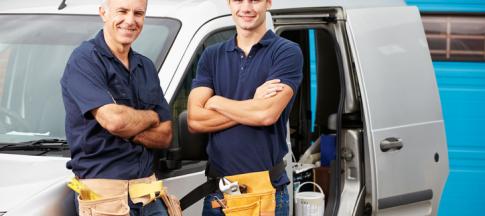
Whether your van is for leisure purposes or you use it as part of your business, the running costs are unavoidable.
But are you spending more than is necessary? We take a look at ways you can reduce your van costs.
Fuel
Your van’s fuel consumption can be improved by taking some simple, straightforward steps.
For a more in-depth guide, check out our article on how to improve your fuel economy.
Tyre pressure
When was the last time you checked your tyre pressure?
Underinflated tyres aren’t just a safety issue - they also create resistance which uses up valuable fuel.
Weight
All that stuff in the back of the van that you don’t really need hammers your van fuel economy.
It’s worth spending an hour or two clearing it out.
Roof racks
Even with no load on, roof racks create wind resistance and use up fuel.
If you don’t need the item or even the rack, it’s best to remove it.
Journey planning
A quick check on Google Maps will show you the most efficient route, which could save you time by avoiding delays.
Keep the windows closed
Having the windows open when driving creates air resistance and uses more fuel. Careful use of air conditioning is probably a cheaper option, especially when on the open road.
Routine servicing
No one likes to pay for that annual service, but it can save money in the long run.
An air filter that’s overdue for change can increase fuel consumption. And if the replacement of a timing belt is overdue, you could have a catastrophic failure on your hands.
Another thing to consider if you bought a used van is, did you ask about its service history?
The same question will be asked when you come to getting rid of your van. If your knowledge of its history is patchy, or even non-existent, you’ll get less for your van.
MOT tests
Most of us aren’t mechanics, but there are a few simple checks we can do to make sure there are no obvious failures.
You should check that:
- all the lights work – watch our video guide on how to check your lights
- the horn is working properly
- the tyres have enough tread and that there’s no damage to the sidewalls – watch our video guide on how to check your tyre tread
- there's no chips or cracks in your windscreen
- there's no dashboard warning lights, like engine management or airbag warnings
Windscreen repairs might be covered on your van insurance policy, so it’s worth checking.
For instance, windscreen repairs are covered on our comprehensive van insurance, excluding Essential tier. Take a look at your policy booklet to see if you have it included.
Tyres
Van tyres get put through the ringer and are prone to failure, just like car tyres.
Check the pressure regularly, as over or under-inflation can cause premature and uneven wear.
Have you noticed a front tyre wearing a lot on the edge, or the steering feeling slightly strange? It’s worth spending a few pounds on having the wheel alignment checked.
Otherwise that worn edge will eventually make the tyre illegal – even if the rest of the tread is looking healthy.
The right tracking helps with fuel consumption, too.
Depreciation
Depreciation just refers to how a van loses its value over time.
This is probably the biggest cost in running a van, but it’s easily overlooked.
Depreciation is unavoidable – but a bit of research before buying your next vehicle could pay off. Some vans hold their value for much longer than others.
Check out our in-depth guide on van depreciation and how you can avoid it.
Should I choose a new or used van?
There’s no debate – a new van that’s bought outright will lose a big sum as soon as it hits the road.
But compared to a used van, you’ll have the full manufacturer's warranty. This is usually for three, five or even seven years.
A van that’s less than two years old will have already taken that big depreciation hit and will still have the reassurance of the remaining warranty (as long as it’s been serviced properly).
What van should I buy?
Finding the cheapest vans to run isn’t easy. Obscure brands may depreciate more quickly than well-known ones so tread carefully - even if the offer looks tempting.
Although a van with all the options fitted is going to cost more at the outset, it’ll be in more demand when you come to sell and will fetch a higher price
Protect your investment
Get minor knocks and scrapes fixed as soon as possible. Otherwise, you might never get around to it and your van’s value will suffer.
Consider having the van vinyl wrapped to protect the paintwork, too. It’s not a cheap option but it may well pay off!
Insurance
It’s a good idea to make sure you’re not paying for services you don’t need, like roadside assistance that you may have covered elsewhere.
Check out our guide on the cheapest vans to insure, too.
How to finance your next van
If you’re running a business, this might be one for you to discuss with your accountant. They might recommend buying it outright, a finance lease or contract hire.
Contract hire has the benefit that the finance company disposes of the van at the end of the period – so you don’t need to worry about depreciation.
But, there can be charges for things like damage and missed services, and you’ll have to find a new van when the term finishes.
I started my career selling vans in the mid-eighties, progressing through dealer groups to management level. In 2010 I joined vehicle valuation company CAP, being made responsible for forecasting future used values for all makes and models of vans and trucks, this data being used by leasing companies and manufacturers to assess future risk. This role entailed very early exposure to new models including extensive testing across Europe.
In 2016 I started up my own consultancy business dedicated to the LCV industry. In addition, my freelance written work has been used by a number of clients and I am a regular contributor to WhatVan? magazine. I’m also a judge for their annual ‘Van of the Year’ awards.
To relax, I enjoy travel and walking near my Yorkshire home.



